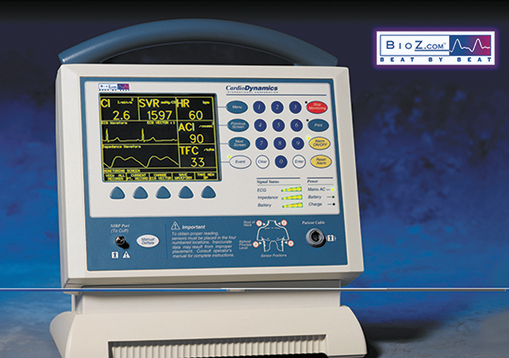
A New Frontier for Cardiac Monitoring
Hemodynamics is defined as the study behind the forces involved with blood circulation. Previously, monitoring these forces presented a costly and invasive procedure, but because of NASA funding and technology, cardiac patients were given a non-invasive monitor that gives accurate data about their hemodynamic status. CardioDynamics International Corporation (CDIC), of San Diego, California has created the BioZ® System through a Small Business Innovation Research (SBIR) award from Johnson Space Center, providing patients and physicians with a cost-effective and highly accurate monitoring system.
The BioZ non-invasive heart monitor is based on a technology known as Impedance Cardiography (ICG). BioZ provides the physician with vital information about the heart's ability to deliver blood to the body, the force one's heart exerts with each beat, and the amount of fluid in the chest. Specially designed bioimpedance sensors placed on the neck and chest monitor 12 different parameters, including cardiac output, contractility, systemic vascular resistance, and thoracic fluid content. These sensors monitor the electrical conductivity of the body-information that is converted into blood flow data and is displayed in real time on a monitoring screen.
Previously, the most effective method for acquiring information about the mechanical functions of the heart was through pulmonary artery catheterization, also known as right-heart catheterization. However, this procedure is invasive, risky, uncomfortable, and often requires a hospital stay. Because of the non-invasive nature of BioZ, the same information can, for the first time, be obtained in a physician's office, as well as in a hospital setting.
Recently, NASA used ICG as a means for studying the effects of hypergravity on the cardiovascular system. Originally, ICG was used to monitor the cardiac output of astronauts in space flight. At the time, ICG worked well in healthy astronauts, but had technological challenges to overcome in order to work for the ailing population who needed it the most. CDIC made significant advancements including the addition of its DISQ™ (Digital Impedance Signal Quantifier) technology and the Z MARC™ Algorithm, increasing the accuracy and reproducibility of this technology. The ICG technology continues to be used by NASA for space research programs because of its ability to produce hemodynamic measurements in an accurate and non-invasive manner.
BioZ.com™ and BioZ.pc™ are two additional products that incorporate the same sensors present in the original BioZ system. The "com" in BioZ.com stands for cardiac output monitor. This fully integrated system is essentially a smaller version of the BioZ, combining the same abilities with a compact, lightweight design, while providing greater portability. The BioZ.pc is a PC-based monitor and has been designed for Internet integration. The information acquired from the sensors in the BioZ.pc is then sent to an Internet database where it can be easily accessed by medical professionals. CDIC is also anticipating the development of BioZ.tel.™ which will allow for hemodynamic monitoring in the patient's home. While this product is not yet available, it will utilize the same base technology and enable the patient to transmit the data to his or her physician through a telephone line or e-mail. CDIC's ongoing effort to reinvent the use of NASA technology has shown remarkable gains in the field of cardiology and medicine. The BioZ ICG technology has been clinically proven to improve patient prognoses and to decrease costs. With its proprietary ICG technology, the company is able to improve the way medicine is practiced around the world and help the medical community battle the number one killer of both men and women--cardiovascular disease.
BioZ® is a registered trademark of CardioDynamics International Corporation.
BioZ.com,™ BioZ.pc,™ BioZ.tel,™ DISQ,™ and Z MARC™ are trademarks of CardioDynamics International Corporation.

The BioZ.com™ noninvasive hemodynamic monitoring system uses Impedance Cardiography to calculate 12 hemodynamic parameters.

A doctor uses the BioZ.com™ technology to monitor a patient’s hemodynamic status in the comfort of an office rather than a hospital.













